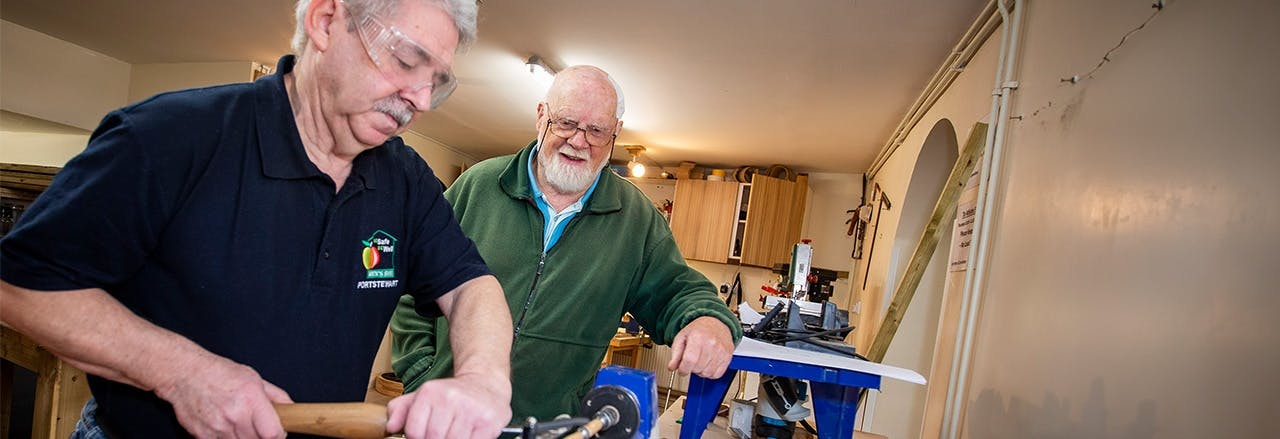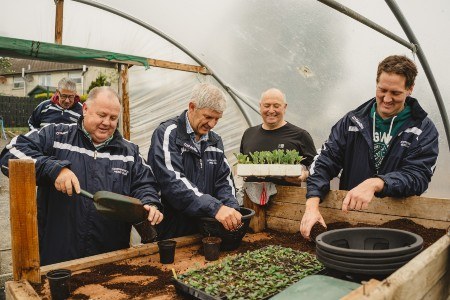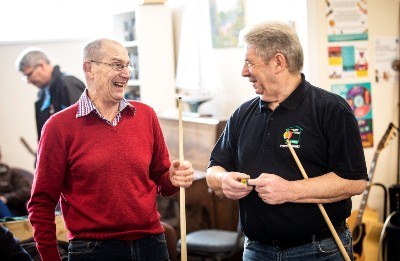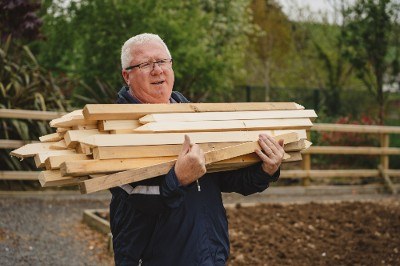
Men's sheds
Men’s sheds offer people the chance to connect with each other while making and mending things. There are over 600 sheds across the UK where (mostly) men build home and garden items like bird boxes, shelving and children's toys, repair electronics, or create ornaments and artwork.
They’re particularly popular with older men, who can be at higher risk of loneliness, and may be less likely to join other social groups. By creating space for casual, shoulder-to-shoulder conversation, sheds can help men open up.
We’ve taken a look at men’s sheds from across the UK to capture seven key things that might help you if you’re thinking of opening one in your community.
We also share evidence of their impact on those who use them. This is drawn from the results of seven surveys of shed members, conducted by: Armagh Men’s Shed (38 participants); Men’s Sheds Cymru (44); Scottish Men’s Sheds Association (62); Action Mental Health's sheds in Downpatrick, Antrim, and Enniskillen (103); Age UK Cheshire men’s sheds (119); and Age Scotland’s network of 101 sheds (133). This may be useful in shaping the priorities of your shed so that it makes the maximum impact.
Listen to this article
You can listen to this article as a sound recording, lasting 21 minutes and 4 seconds, by clicking the button below.
I thoroughly enjoy the company and like learning new skills and learning new things I thought I wasn’t capable of.Member of Armagh Men’s Shed
1. Skills, purpose, and choice: offering the right activities

Shedders, as participants are sometimes known, like doing something that feels productive. As we found from our Ageing Better programme, men may be “less likely to socialise for the sake of socialising and would rather have another reason for going out and meeting other people”.
Here are ways to make sure you offer the right activities for your shedders:
- Take ideas and suggestions. Across the UK, sheds offer a wide variety of activities, from woodworking and renovating community buildings to IT classes, building model train sets and singing in a choir. By listening to shedders, you can make your shed bespoke, with men choosing what they want to work on rather than following a blueprint.
- Offer flexibility. Would someone rather take part in a pre-planned woodworking session, or mend their own broken chair? Do they like working on something that benefits the community, or something for their own home? When shedders follow their own interests, it increases engagement, and gives them ownership.
- Consider purposeful, skill-based activities. When Age Scotland interviewed its men’s shed members, their top three reasons for joining were to learn new skills, put their skills to use, and help the community. Evidence confirms that sheds help them do this: a majority of respondents (between 75%–97%) to the surveys listed above said they had learned new skills. At Downpatrick, Antrim, and Enniskillen sheds, many “rekindled skills and interests” in woodwork and basket weaving, while others enjoyed learning IT skills they could use at home.
- Give people the chance to give back. Especially for older men, using knowledge and skills is great for fostering self-esteem and a renewed sense of purpose after retirement.
It’s amazing how we would tell each other about ourselves and our own home life that we would never say to anyone else.Member of Armagh Men’s Shed
2. Supportive and relaxed: getting the environment right
The most popular men’s sheds have an atmosphere that’s casual, comfortable and familiar. We hear that, for some men, it’s easier to open up about personal issues in this environment than it would be in other settings like GPs or support groups.
The following tips could help you create an informal and inclusive atmosphere:
- Let shedders choose their pace in any given session. Llandudno Men’s Shed found that its members fell into “two camps: those who wish to sit around, drink coffee and chat, and those who wish to be more practical and do things. These are not mutually exclusive, you can fit in both camps or just one.”
- Keep it casual. Many sheds raise money by selling the items they make, but there are risks – particularly if this is the shed’s sole or major source of income. The need to make sales can make the activities feel like a chore or obligation for some shedders, or even cause stress. Make sure nobody is trying to do more than they can manage.
- Make it physically comfortable. Seating makes it easier for shedders to relax and chat with people as they work, offering tips and friendly conversation. This is particularly important for people with health conditions or mobility issues that fluctuate, meaning that on some days practical work is possible and on other days they need to take it easy. We supported Bethesda Neyland Men’s Shed to introduce wheelchair friendly seating, so that everyone could take part.
- Keep it cosy. Evidence suggests that keeping warm is particularly important for people over the age of 65, or who have medical conditions. 18°C is the recommended minimum temperature. During the winter cost of living crisis, The Wee County Men’s Shed in Clackmannanshire found that older members were staying longer at the Shed, avoiding putting the heating on at home. We awarded a grant of £6,000 to help the group extend its opening hours and keep the space warm.
- Make it easy to get to. People are much more likely to attend activities close to where they live. And locating the shed in the centre of the community makes it more accessible and approachable, particularly for those who find physical activity harder.
- Can everybody access your premises? This could mean step-free access for wheelchair users and those with limited mobility, or improved support for people with dementia. We awarded £10,000 to make Barnsley Men’s Shed dementia-friendly. Volunteers received training, put up clear signage, and rearranged the workspace to create a quiet area. In partnership with the local She Shed, the group set up weekly mixed-sex dementia-friendly sessions.
It’s the people that make the place…the most important thing is the kettle.Member of Armagh Men’s Shed
3. Making friends, making connections

Men are more likely to be socially isolated than women. By offering connection and a space to talk, sheds can help to address this. For many, the most important benefit is not what they create or mend, but the relationships they build with other shedders.
At Action Mental Health’s sheds, 100% of 103 respondents said they had made new friends, with an average of 13 new friendships each.
Here are some ideas you could try to help your members build trusting, supportive friendships that extend beyond the workshop:
- Keep men coming back by offering a varied, ongoing programme of activities and projects, informed by what they enjoy and ask for. And don’t force conversations. Participants are more likely to build relationships while building a window box planter for a local school or re-upholstering an armchair, rather than “sitting around drinking coffee,” as one participant put it.
- Pay attention to older men. We know that older men are at greater risk of social isolation – and that sheds can help address this. For example, you could consider multi-generational sessions – a chance for men to teach their skills to younger people (or vice versa), and feel that their knowledge and experience is valued.
- Be mindful of caring responsibilities. Time in a shed gives some participants a rare break. As one put it, “I needed to meet other people for social and companionship as I am my wife’s carer and don’t have much ‘me’ time.” This means that time is precious and they might have specific ideas about how they’d like to use that at the shed.
- Find ways to connect your shed with what’s going on locally. Research suggests that social connectedness helps to improve wellbeing and reduce the impact of challenging life situations. We've seen shedders getting to know and contributing to local community centres, schools, groups, and younger generations through activities that link them together. At all sheds surveyed, at least half of members felt a greater sense of belonging or being a more active part of their community. In Armagh, 97% of members feel more involved in the community as a result of taking part – explained by the collaboration with seven schools and 17 churches and charities.
I have made around 22 new friends who I would never have met but for the men’s shed.Age Scotland survey respondent
4. Recruiting shedders
There are many ways to spread the word about your shed.
- Promote your shed in places where local men go. That could mean schools, sports venues, pubs, working men’s clubs, barbers, or churches, temples, and mosques. You can also market your shed to the families of potential members: some dads, husbands, or brothers might need encouragement to join.
- Advertise your shed in your local bumping spaces – places where people naturally run into each other, like supermarkets, village halls, and doctors’ surgeries. Stalls at local events are another good way to share information.
- Hold open days. Encourage people to visit the shed and learn what is on offer. Targeted sessions are a good way to reach specific groups of men. Church Crookham and Fleet Men’s Shed found that potential members were sometimes intimidated by the crowds of people at its open days. This shed knew there was a significant local ex-military population, and wanted to involve more veterans. Partnering with the Royal British Legion and Armed Forces Connect, it used a small National Lottery grant to hold open days just for veterans.
- Can your shed help the wider community? Shedders could build plant boxes for a community centre, or paint fences for a local school – with the double benefit of spreading the word and showing practical support for other local organisations.
- Schedule sessions to reach different audiences. Men in their 50s and early 60s may be unable to attend weekday activities during working hours – but the same sessions could be attractive to men who are retired.
5. Men-only and mixed-sex sheds
Evidence suggests that men-only spaces are beneficial and wanted. Stereotypes and stigma may still make men feel that they have to mask their vulnerabilities, especially in front of women. In a study of Mind’s peer support groups for men, focus groups reflected that “people get shy – they don’t want to talk about problems, especially in front of women”, explaining that “if women were there then I guess you would have to perform again.”
All-male spaces can make it easier to talk about both physical and mental health. Jason Schroeder, who started the Scottish men's shed movement in 2009, called sheds “a social place for men to relax in their own company. They don’t have to watch their Ps and Qs, they can have their own type of banter. They can talk about prostates and all sorts of health issues which they are never going to talk about in front of women.”
And male-only spaces may be especially important for men from communities, where women and men are less likely to socialise together.
That said, sheds can also be mixed sex – though it might take time for everybody to adjust. When Ceri Alderton joined Dunoon Men’s Shed, “the guys used to apologise for swearing in front of me,” she told the Scotsman, “but they don’t do that any more.”
She points out that different places might have less accepting views; in another shed, “one guy said if a woman comes in here I am leaving.” And she stresses that the shed is primarily intended as a support network for men.
Here are things to consider about male-only and mixed-gender sheds:
- The law on single-sex spaces. Under the Equality Act 2010, voluntary organisations can restrict their services to one sex only if it is a “proportionate means of achieving a legitimate aim”. The Equality and Human Rights Commission has published detailed guidance on single-sex services and the Equality Act.
- Even if a shed is men-only, it can still involve women in various ways, such as referring men to join, or taking trustee or leadership roles. Some sheds organise mixed-sex sessions, open to everyone. Others have women’s shed groups, which meet separately to the men’s, but might share premises, be run by the same organisation, and sometimes work on projects together.
- So far, there is little evidence available regarding transgender and non-binary shed members. If your shed includes trans and non-binary people, think how you will support them, and make sure that everyone feels comfortable and accepted.
6. Promoting better health

Sheds support wellbeing. For example, at Men’s Sheds Cymru, 89% (39) of 44 respondents said they “feel better” since joining.
Some use the Warwick-Edinburgh Mental Wellbeing Scale to measure changes in wellbeing before and after being part of a shed for six months or more. Age UK Cheshire found that all 119 surveyed men had better wellbeing after six months, while between 47% and 55% agreed more strongly with statements about feeling “relaxed”, “useful”, and “cheerful”.
Men’s sheds can also help people live physically healthier lives – both through increased activity and by encouraging members to take greater care of their health.
For example, sheds helped 48% of participants in Scotland to deal with existing health issues, while some others had been motivated to improve their diet (8%), lead a healthier lifestyle (5%), drink less alcohol (8%) and leave the house more often.
Here are ways your shed could help improve members’ physical health:
- Just coming along can lead to increases in physical activity. Age Scotland found that as many as 85% (113 out of 133) of shedders were “more active as a result of being involved in the shed”. Another Scottish study found lower rates of improvement, with 32% (20 of 62) being more active. The difference partially reflects the different methodologies and levels of physical activity in the sheds, but both studies found that increases in activity came from spending time ‘on your feet’ on the shed’s activities and from regularly walking to the shed itself.
- Support the right level of physical activity. Given the age cohort and the level of long-term health conditions among participants (sometimes one in four), there is a risk that taking part leaves some with less energy for other things. Age UK Cheshire found that having energy to spare was the least common improvement and almost one in five had less energy than before (18% or 22 out of 119 respondents). But the trend was still positive overall, with 82% (97) reporting that they had more or the same amount.
- The relaxed atmosphere can make the shed a good place to seek or offer health advice. You could invite healthcare professionals to share advice on issues such as dental hygiene, diabetes, and high blood-pressure. You can offer in-depth conversations about health conditions specific to men, such as prostate and testicular cancer. Armagh Men’s Shed hosted health talks on topics including bowel cancer, dementia, hearing loss. It also offered a six-week health awareness course, including blood pressure and weight checks.
- Linking with healthcare professionals might be easier for well-established sheds that have had time to build up their membership and network of contacts. Smaller sheds might offer less formal support, with positive outcomes coming mainly from increased physical activity and social contact.
- As well as inviting speakers, you could offer signposting to other services, or join a local social prescribing scheme. Even putting up posters can help raise awareness of common health issues.
- Make sure men are encouraged to seek appropriate healthcare if they need it. The UK Men’s Shed Association (UKMSA) provides a list of organisations and resources that can help with physical and mental health.
Coming to the Shed it makes you feel better, it makes you want to do things, you have more energy and want to do stuff. And that’s part of looking after yourself as well, trying to do some more exercise.Shed participant, Scotland
7. Health and safety
Safety is essential in any workshop or shed. Some activities might involve high-risk equipment like power tools. The venue should have fire safety and first aid measures. And safeguarding should be taken seriously, particularly when working with vulnerable shedders who might need extra care, or be at greater risk of abuse or neglect.
Here are ways to make your shed a safe working environment.
- Agree a health and safety policy, outlining what you’ll do to keep people safe. UKMSA offers templates you can use to build yours, as does the Scottish Men’s Sheds Association (SMSA). The policy should be clearly displayed, ideally both onsite and online. UKMSA and SMSA also have templates for risk assessment, which help you identify potential dangers and the precautions you should take to prevent them. The risk assessment should be regularly updated.
- Offer basic health and safety training to members. We’ve awarded grants to many sheds to cover the cost of safety and equipment training. Giving shedders a sense of ownership is helpful: it’s everyone’s shed, so safety is everyone’s responsibility. UKMSA suggests asking all shedders to agree to basic safety rules, such as “Do not talk to someone who is using a machine”, “clear surfaces are safer”, and “ask for help if lifting”. Induction for new members should include safety training.
- You should have trained first aiders and safety supervisors on site, particularly when activities have a higher risk of injury. You could train shedders to take these roles – giving them the opportunity to learn new skills.
- Make sure everyone knows the risks to look out for. UKMSA has designs for safety posters that you can print and display. Posters should have large, clear fonts, and be available in the languages spoken by shedders.
- Keep the premises safe. Make sure you have fire safety guidelines and equipment, signage and allocated assembly points. Provide appropriate personal protective equipment, such as goggles and gloves. Check dust levels regularly, and make sure workshop environments have suitable ventilation and dust extraction.
- Have a clear policy on safeguarding. This protects people who may need extra care or support (perhaps through disability, age, or illness), or who may be more vulnerable to abuse or neglect. UKMSA offers safeguarding policy templates, with recommendations for prevention, checks, and reporting procedures.
- Make sure you have adequate insurance, such as protection for property, liabilities to people, fundraising or events, trustee protection and cash held on site.
8. Resources
The men’s shed movement has been going since the 1990s, so there is plenty of guidance available.
- In 2021, we funded Glasgow Caledonian University to create this comprehensive toolkit for developing and sustaining men’s sheds.
- Resources and information are available from the UK Men’s Shed Association, Men’s Sheds Cymru, Scottish Men’s Sheds Association, and Groundwork NI. Be aware that policies and templates for one country may not fit with legislation in another.
- It’s also good to contact established sheds in your area, who may have specific advice on local questions.
Want
to find out more or share your story?
If you have great ideas from your own experience, please consider sharing them with us at knowledge@tnlcommunityfund.org.uk.
And if you’re interested in further reading, our report on Social Prescribing highlights how other community activities such as men’s sheds can help to improve wellbeing.